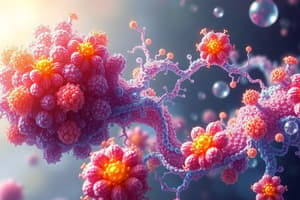Podcast
Questions and Answers
What is the definition of primary productivity?
What is the definition of primary productivity?
- Rate at which solar energy is converted into organic compounds via photosynthesis over a unit of time (correct)
- Percentage of energy transferred from one trophic level to another
- Total rate of photosynthesis in a given area
- Rate of energy storage by photosynthesizers in a given area
What does GPP stand for?
What does GPP stand for?
Gross Primary Productivity
What is the formula for calculating Net Primary Productivity (NPP)?
What is the formula for calculating Net Primary Productivity (NPP)?
NPP = GPP - R
What percentage of solar energy is captured by green plants and bacteria?
What percentage of solar energy is captured by green plants and bacteria?
A food web is a network of complex interactions formed by the ________ relationships among various organisms.
A food web is a network of complex interactions formed by the ________ relationships among various organisms.
Herbivores eat both plants and animals.
Herbivores eat both plants and animals.
What are decomposers?
What are decomposers?
Match the following terms to their definitions:
Match the following terms to their definitions:
Flashcards
Primary Productivity
Primary Productivity
The rate at which solar energy is converted into organic compounds through photosynthesis.
Gross Primary Productivity (GPP)
Gross Primary Productivity (GPP)
The total rate of photosynthesis in a specific area, converting solar energy into biomass.
Net Primary Productivity (NPP)
Net Primary Productivity (NPP)
The rate of energy storage by photosynthetic organisms, calculated as GPP minus respiration (R).
Ecological Efficiency
Ecological Efficiency
Signup and view all the flashcards
Food Web
Food Web
Signup and view all the flashcards
Scavengers
Scavengers
Signup and view all the flashcards
Omnivores
Omnivores
Signup and view all the flashcards
Carnivores
Carnivores
Signup and view all the flashcards
Study Notes
Key Concepts in Photosynthesis and Ecosystem Dynamics
-
Primary Productivity: Refers to the rate at which solar energy is converted into organic compounds through photosynthesis over a designated time period.
-
Gross Primary Productivity (GPP): The total rate of photosynthesis in a specific area, representing the conversion of solar energy into biomass by producers.
-
Net Primary Productivity (NPP): Calculated as NPP = GPP - R, where R is the energy lost due to respiration. It indicates the rate of energy storage by photosynthetic organisms in a given area.
-
Ecological Efficiency: Represents the percentage of energy transferred from one trophic level to another within a food chain or web, crucial for understanding energy flow in ecosystems.
Ecosystem Interactions
-
Food Web: A complex network of interactions formed by feeding relationships among various organisms in an ecosystem, providing resilience to ecological changes.
-
Scavengers: Animals that feed on the remains of dead organisms, playing a key role in nutrient cycling and energy transfer.
-
Omnivores: Organisms that eat both plants and animals (secondary consumers), contributing to various trophic levels in food chains.
-
Carnivores: Organisms that primarily consume other animals (secondary consumers), utilizing energy gained from their prey.
-
Herbivores: Primary consumers that exclusively feed on plants, serving as a critical link in energy transfer from producers to higher trophic levels.
Organism Roles in Ecosystems
-
Detrivores: Feed on dead plant and animal matter (e.g., earthworms, beetles), facilitating decomposition and nutrient recycling.
-
Decomposers: Organisms, often bacteria and fungi, that break down wastes and dead organisms, crucial for returning nutrients to the ecosystem.
-
Plankton: Tiny organisms that float in aquatic environments, forming the base of the marine food web and vital for sustaining life in oceans.
Energy and Environment
-
Solar Energy Capture: Only about 0.023% of solar energy is harnessed by green plants and bacteria, highlighting the inefficiency of energy conversion.
-
Natural Sources of Greenhouse Gases: Include processes such as decomposition, volcanic activity, combustion, and respiration, emphasizing the natural contributions to atmospheric changes.
-
Primary Productivity Distribution: NPP is predominantly found in oceans globally while being most concentrated per unit area in estuaries, indicating areas of high ecological productivity.
Studying That Suits You
Use AI to generate personalized quizzes and flashcards to suit your learning preferences.




